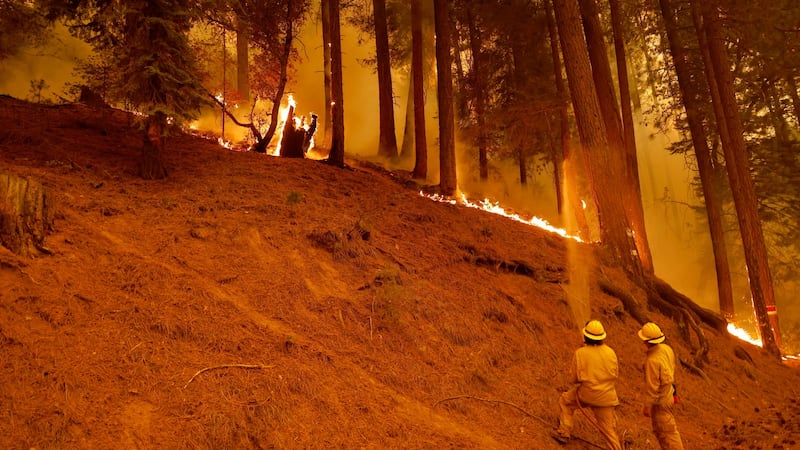The death toll in fires ravaging mountain forests and villages in Algeria’s Berber region climbed on Wednesday to 65 people, including 28 soldiers, as the president declared a three-day mourning period this week to honour the lives lost.
The Civil Protection authority announced the rising number of victims, up from 42 on Tuesday.
President Abdelmadjid Tebboune said his North African nation would enter a three-day period of mourning starting on Thursday that would include suspending all government activity except for actions of solidarity.
Dozens of fires began devouring forested mountainsides in the Berber region of Kabyle, east of Algiers, the capital, on Monday, destroying village homes, olive tree orchards and animals that provide a livelihood for the region.
The forestry director in Tizi-Ouzou, the regional capital, said on Wednesday that 18 fires remain active in the region. Dozens of fires burned elsewhere across the north, but their deadly force was concentrated in Kabyle.
There was no official explanation of the high death toll among soldiers but photos in Algerian media showed soldiers in their army fatigues with no protective firefighting clothing.
The prime minister and interior minister both said on Tuesday that arson was suspected in the Kabyle blazes, despite a heat wave and high winds fanning the flames.
Citizens, mainly youths, are helping to supply residents in need and “caravans of solidarity” were heading to Tizi-Ouzou, the online media outlet TSA reported.
North Africa has been sweltering under searing temperatures, including in neighbouring Tunisia where scattered fires in the east were reported.
Algeria’s National Meteorology Office reported high temperatures were expected through Thursday in nearly a dozen wilayas, or regions, including around Tizi-Ouzou. In some places, the thermometer was forecast to hit 47 degrees Celsius.
Climate scientists say there is little doubt that climate change from the burning of coal, oil and natural gas is driving extreme events, such as heat waves, droughts, wildfires, floods and storms.
Italy
Fires ravaged southern Italy on Wednesday, burning thousands of hectares of land and killing a man in his home, as temperatures hit records well above 40 degrees Celsius and hot winds stoked the flames.
Multiple blazes erupted in Calabria, the toe of Italy’s boot, where a 76-year-old man died after his house collapsed due to the flames, Ansa news agency reported.

“Yet another victim of the fires. We are losing our history, our identity is turning to ashes, our soul is burning,” the mayor of Reggio Calabria, Giuseppe Falcomata, wrote on Facebook. He urged people to keep away from the affected areas.
Fires are also sweeping through Sicily, destroying trees and threatening property in the southern and central parts of the island, local media reported. In the town of Floridia, in southern Sicily, the temperature reached 48.8 degrees Celsius in early afternoon, the highest temperature ever recorded in Europe, daily newspaper Corriere della Sera reported, citing the regional meteorological information system.
Firemen said on Twitter they had carried out more than 3,000 operations in Sicily and Calabria in the last 12 hours, employing seven planes to try to douse the flames from above.
Fuelled by the hot weather, fires have erupted across southern Europe in recent weeks, with huge damage to the landscape on the Italian island of Sardinia.
In Greece, many villages on the Peloponnese peninsula were evacuated on Wednesday as exhausted firefighters battled wildfires for a ninth consecutive day.
US
California’s largest single wildfire in recorded history kept pushing through forestlands on Tuesday as fire crews tried to protect rural communities from flames that have destroyed hundreds of homes.
Burning through bone-dry trees, brush and grass, the fire in California by Tuesday had destroyed more than 1,000 buildings, including nearly 550 homes. Much of the small community of Greenville was incinerated during an explosive run of flames last week.

The Dixie Fire, named for the road where it started, also threatened 14,000 buildings in more than a dozen small mountain and rural communities in the northern Sierra Nevada mountain range.
Crews have cut thousands of acres of new fire lines aimed at preventing the fire from spreading. Officials believe the fire lines created on the blaze’s southern side will hold the fire at bay there, but the fire’s future is unknown, authorities said.
Temperatures are expected to rise and the humidity is expected to fall over the next few days, with high temperatures possible later in the week along with a return of strong afternoon winds, fire meteorologist Rich Thompson warned.
California’s raging wildfires are among some 100 large blazes burning across 15 states, mostly in the west, where historic drought conditions have left lands parched and ripe for ignition. – AP/Reuters









